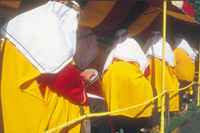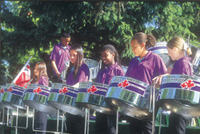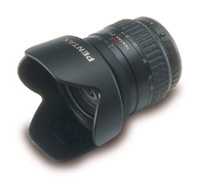Pentax FA 24 to 90mm f3.5 to 4.5 AL [IF] Zoom And FA 31mm f1.8 AL Limited Lens
|
Best known for their line of highly rated compact cameras with built-in zooms, Pentax has also continued to develop their line of SLR cameras and accessories. Their two most recent lenses--introduced in conjunction with the MZ-S, a semiprofessional SLR--offer an indication as to the direction this manufacturer is taking. Entirely different in many respects, the compact FA 24-90mm f/3.5-4.5 AL [IF] zoom and the FA 31mm f/1.8 AL Limited lens do have some similarities. Both autofocus models incorporate aspherical elements, advanced mechanical components plus close focusing and full compatibility with manual focus cameras. The "aspherical" elements provide more consistent edge to edge sharpness at wide apertures, counter comatic flare, and reduce barrel distortion, the bowing outward of lines near the edge of the frame. Several manufacturers use new methods for creating affordable aspherical elements, such as bonding resin to the glass to form a non-spherical surface layer. Such "hybrid" aspherics are used in the zoom lens while the Limited model incorporates more expensive ground and polished aspherical elements. |
||||
I find Editor at Large Bob Shell's description of aspherical elements to be the most clear and concise of any that I have read: "They bend the light to different degrees depending on where the light passes through the lens. This is achieved by varying the curvature which changes across the lens surface from the optical axis out to the edge." With such elements, the designers can reduce the number of lenses required for high sharpness at the edges of a frame, even at wide apertures. Thus, overall weight and the propensity for flare (typically worse with more air-to-glass surfaces) can also be minimized. Zoom Lens Characteristics Incorporating two aspherical elements plus a low dispersion glass element, the combination helps to assure high sharpness across the entire frame at both ends of the zoom. At short focal lengths, it offers the benefits mentioned earlier; at longer focal lengths, it controls chromatic aberration for higher edge sharpness and superior color rendition, especially at wide apertures. This zoom also includes other noteworthy characteristics. Focusing Operation |
||||
The AF sound level (high pitched) is comparable to that of many lenses. Manual focusing is precise, with adequate friction or torque in the mechanism. The rotary zoom mechanism is smooth as well. Thanks to extensive use of impact-resistant polycarbonate material, this is a lightweight lens but its stainless steel mount offers high durability. Nicely finished in satin black, it includes an aperture ring with detents at half stops at the wider apertures up to f/11. A distance scale is provided but there is no depth of field scale, a common omission with rotary action zooms. Anti-flare strategies include SMCP multi-coating and a removable notched (corner-cut) hood designed to shade the front element at all focal lengths. The hood has a removable section that allows for convenient adjustment of a polarizer without removing the hood or taking the camera from eye level to fiddle with the filter. The Pentax designers should be congratulated for this innovative concept, common on many of their newer zooms. |
||||
Zoom Lens Evaluation In images of a rectangular building, I noted slight barrel distortion (bowing outward of straight lines near the edge of the frame) at the shortest focal lengths. This might create some concern in formal architectural photography, but that's not the intended use for lenses of this type. At all focal lengths and apertures from f/5.6 to f/16, the zoom produced highly satisfying slides, suitable for an excellent 8x12" print or a full-page magazine reproduction. Peak optical performance--adequate for a fine 11x14" print--was obtained in the 28-70mm range, at f/8 to f/11. I would happily continue using this zoom for my professional stock photography, because many of my slides would satisfy demanding photo buyers. |
||||
The Limited Edition Lens
Although it is an autofocus model, this lens is reminiscent of those made three decades ago. Naturally, it incorporates the latest computer-designed high grade optics, SMCP multi-coating, and a floating mechanism that controls fluctuating aberrations in close focusing. The latter is important, because this wide angle lens will focus as close as 12". The focus ring does rotate during AF operation, but in manual focus operation it's very well damped so it feels just like a conventional lens. The front element does rotate a bit when focusing, but the effect of a polarizer is not changed much. The 31mm focal length is not common today, but this is no common lens. It is expensive, as one could guess from the impeccable metal construction and milled focus and f/stop rings, finely engraved numerals (including depth of field scale), the built-in metal hood and aluminum lens cap that fits over the hood. Intended for the discriminating photographer, the FA 31mm f/1.9 offers high prestige value, excellent construction, and an elegant retro-look that's reminiscent of some classic lenses. Aside from its high visual and tactile appeal, this lens produces optical performance that's commensurate with the price: absolutely superb at all f/stops from f/2.8 to f/16. The wider apertures are very useful for problem solving in low-light situations where flash and tripod are impractical. Even in extreme close focusing, excellent results are provided at all f/stops, particularly at f/8 and f/11. Stop down when possible, use professional photographic techniques and you can expect image quality suitable for beautiful 16x20" prints. |
||||
Although the 24-90mm zoom is more versatile, this 31mm lens offers two significant advantages: the much wider maximum aperture allows the use of slower (high resolution) film in handheld photography and reduces the need for flash or a tripod in low-light situations. It is also more effectively corrected for linear distortion. More importantly, the 31mm lens produces images with higher sharpness at the edges of the frame, most noticeable in the f/4 to f/5.6 range; even at f/1.8 to f/2.8, the optical performance is impressive: suitable for a very good 8x12" print. Final Evaluation For more information, contact Pentax Corporation at (303) 728-0212; fax: (303) 790-1131; www.pentaxusa.com. |
||||
Pentax FA 24-90mm f/3.5-4.5
AL [IF] Zoom |
||||
FA 31mm f/1.8 AL Limited |
- Log in or register to post comments










































